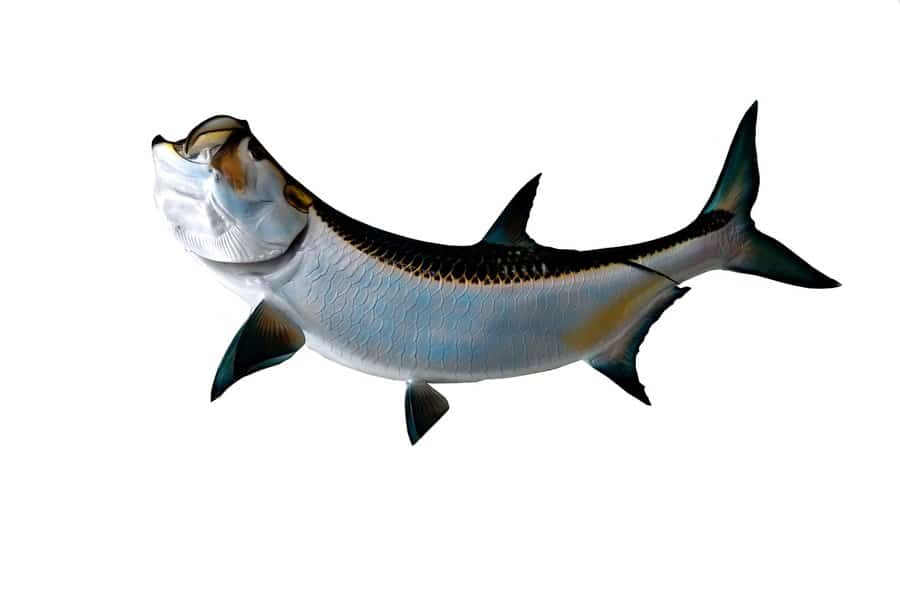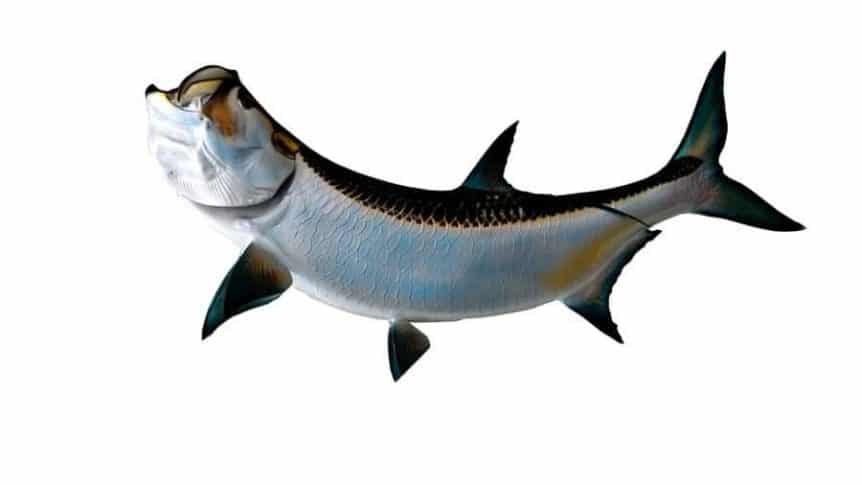
Fishing for Tarpon in Costa Rica can be done in any month of the year. In January swarms of Tarpon invade the Rio Colorado and surrounding waters and are here by the thousands from January through May. In September and October the numbers dip and only scattered tarpon are found in the rivers and lagoons. Instead, they congregate in vast numbers just outside the river mouth in the Caribbean.
Below we will discuss the basics of Tarpon fishing in Costa, and how you can get the most out of each and every one of your days of tarpon fishing in Costa Rica.
Fishing For Tarpon in Costa Rica
The locals call them Asabalo and the king of game fish journeys from saltwater into freshwater at will. When the tarpon start hitting, anglers from all around the world head to Costa Rica to tangle with the incredible silver king.
The best locations, strategies and times to catch tarpon in Costa Rica vary but an expert tarpon with over 20 years of experience fishing in Costa Rica will tell you about proven secrets to help shorten your path to success with live bait, lures and flies.
They roam the warm inshore waters of the Caribbean Sea along the entire Eastern seaboard of Costa Rica as well as venture up the many rivers that flow to the coast. In the northwest part of Costa Rica Tarpon average 75 pounds and some exceeding 150 pounds are caught each season.
Costa Rica Tarpon commonly travel up the Rio Colorado into the Rio San Juan all the way to Lake Nicaragua. Fishing is more apt to change day to day rather than season to season.
The fish are always present and current local weather conditions will play the major factor in what its feeding habits will be on any given day.
Tarpon Fishing Techniques For Costa Rica
Twenty year resident of the country, Todd Staley lived in the jungle rainforest of Barra del Colorado nearly five years and we consider him somewhat of an authority on the habits of the Costa Rican tarpon.
He caught his first tarpon in Florida at the age of 10 and more than a thousand silver kings later they are still his favorite game fish. When asked by an angler what kind of a day they can expect for fishing tarpon in Costa Rica, Todd always gives the same reply.
“On my worst day fishing tarpon here I hooked zero, but on my very best day I jumped sixty.”
I think I can safely say that you will fall somewhere in between those two numbers.
The best advice he can give is to listen to your guides and fish with the lures and techniques they suggest. Especially if you are an experienced tarpon fishermen and fishing in Costa Rica for the first time, leave that knowledge in your suitcase.
He adds, the techniques for fighting a tarpon in Costa Rica are universal; the techniques used to fool the tarpon into taking your offering vary from location to location.
River Fishing For Tarpon in Costa Rica
Tarpon in Costa Rica are always present in the Caribbean and in the river and lagoon systems.
The Tarpon travel in huge schools on the ocean and in small pods or singles once they enter the fresh water, although in February, March, and April they occasionally school up in the lagoons.
Large groups of tarpon begin entering the rivers in December and travel upstream for several months until they return to the ocean in May.
There are also a few resident fish that for some reason choose to stay inside year round in the rivers and lagoons.
Fishing is done on the main river in the holes behind the sandbars formed by the current changes near the river bends. Boats anchor in front of the drop offs and work floating Rapalas or flies back in the holes.
If you are lucky enough to find the tarpon schooled up in a lagoon, casting a 65M MirrOlure or working a fly produces some adrenalin pumping acrobatics when in the shallow water the fish have nowhere to go but up.
During the fat Snook run from late November to early February, light tackle anglers are often surprised when an eighty pound tarpon takes in a jig intended for a five pound fish.
Tarpon begin their move inside the rivers in January and build up to a peak during the spring months.
Even famous fly fisherman Bill Barnes who started the Casa Mar Lodge readily admits his target was tarpon on 16 pound tippet when his world record snook hit.
River Mouth Tarpon Fishing in Costa Rica

The nutrients flowing out of the rivers compliment the entire food chain right up to the tarpon, snook, giant jack crevalle, and the assortment of pelagics that pass through seasonally. On a very calm day, one can sneak up behind the sand bars and fool big snook and tarpon laying in ambush.
If there is a swell, the drift is begun just behind the breakers and the lures are worked while drifting out until reaching about a 40 foot depth, then the boats move back in and the process is repeated.
When the conditions are right and the fish hungry, it is common to have at least one strike on every drift.
Fishing The Outside in Costa Rica
It is an awesome sight to see an acre of tarpon rolling in unison. Tarpon school up off the beaches and just offshore and move up and down the coast and hang in certain areas like the horseshoe shaped tide rip offshore as the blue Caribbean bucks against the dark river water.
Most ocean fishing is done by jigging in 55 to 65 feet of water, which is less than a mile off the beach and fishing rarely is done much deeper.
If you’ve heard stories of jumping two or three tarpon on a single cast it was probably done in this area as one fish throws the lure and another takes it as it hits the water.
Where to Fish for Tarpon Fishing in Costa Rica
Barra del Colorado
Barra has the largest watershed on the Eastern seaboard. There are endless miles of creeks and lagoons and three river mouths within a twenty minute run in a boat.Also the Rio Colorado has the bulk of the water running out of Lake Nicaragua and is a highway for tarpon moving inside.
The last pueblo before the Nicaraguan border, it has also less traffic than the areas near the canal that runs inside from Limon to the Barra.
Parismina
When the ocean is calm and fishing is done outside, Parismina is equally as good as Barra del Colorado or probably anywhere in the world to fish tarpon. On the days the breakers in the river mouth don’t allow a safe passage outside, the fishing can be tough.
The smaller area to fish and the boat traffic headed to the nature lodges in Tortugero play into the fish count taken inside the river mouth.
Tortuguero
Although primarily visited by nature groups and known as a prime nesting sight for the green turtle, Tortuguero does have lodge operators that offer fishing.
Most boats fishing tarpon out of Tortuguero generally head north towards Barra del Colorado looking for tarpon. The rocky bottom outside the Tortuguero river mouth makes it a good area for Snook and cubera snapper as well as for holding king mackerel during the bi-annual migration.
Again, the lack of water area to fish inside as well as boat traffic doesn’t make it our 1st or 2nd choice.
Tips and Tackle For Tarpon In Costa Rica
Rods of 6 1/2 to 7 feet designed to handle 12 to 20 pound line are most popular. Twenty pound line is practical, though 12 and 15 are used frequently. Because some tarpon fishing is done with lures weighing around two ounces, sufficient rod backbone in tip and butt section is desired.
Because tarpon average 80 lbs, the butt strength is important to raise them by jumping. Reels should be sturdy, with smooth drag systems, and have a capacity of at least 200 yards of the test line you choose.
Fly Fishing for Tarpon
For Tarpon, rods that will handle 12 or 13 line are best. Snook can be fished with success on tackle which handle lines in size 8 or 9. Tarpon reels, of course, should have a very smooth drag and have capacity of at least 200 yds with 20-30 backing.
On occasion it’s not necessary to go deep, so we urge fly fisherman to bring a variety of shooting heads up to 850 grains. Don’t forget to bring your lighter bass or trout gear for the smaller species such as machaca and guapote. They provide lots of sport on tackle matching their size.
Choice of tackle depends upon both a fisherman’s skill and his desires. Recommendations here are simply general guidelines.

